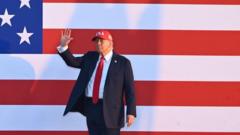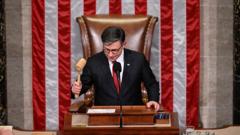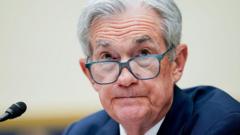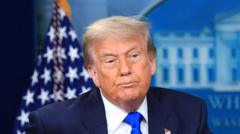The increasing U.S. debt, now at $37 trillion, raises questions about its sustainability and economic impact, especially following the passage of Trump’s significant tax-cutting budget plan.
**Is the U.S. $37 Trillion Debt a Cause for Concern?**

**Is the U.S. $37 Trillion Debt a Cause for Concern?**
Experts weigh in on the implications of America's soaring debt in the shadow of a new budget bill.
The U.S. national debt has escalated to an astounding $37 trillion following the recent approval of the Big Beautiful Budget Bill by Congress, championed by former President Donald Trump. This development has reignited concerns regarding the long-term viability of America's borrowing habits. Critics of the plan, including prominent figures such as Elon Musk, highlight the potential pitfalls of adding approximately $3 trillion to an already substantial debt.
With the increase in borrowing, questions arise about the world’s willingness to finance the debt. Market indicators reflect this anxiety, as seen in the declining strength of the dollar—down 10% against the British pound and 15% against the euro this year—and an uptick in interest rates demanded by investors for U.S. loans. Despite overall stability in borrowing costs, indications such as a steepening yield curve demonstrate higher apprehension regarding the sustainability of debts in the long term.
Ray Dalio, CEO of one of the world's largest hedge funds, warns that the U.S. is approaching a critical juncture. He predicts that, if unchecked, debt repayment could reach $10 trillion annually. To avert a crisis, he suggests urgent measures such as reducing the budget deficit from 6% to 3% promptly. However, the current trajectory of Trump's budget cuts emphasizes tax reductions, not necessarily a decrease in overall government spending.
The potential paths forward reflect the gravity of this financial situation. A severe reduction in government spending or a substantial tax increase could be necessary, but such measures face significant political hurdles. Alternatively, the U.S. central bank might resort to printing more money, risking inflation and widening economic disparities, or, in the worst-case scenario, the nation might face a default. An inability to honor debts would undermine global confidence, given how fundamental the U.S. Treasury is to world financial stability.
Counterbalancing these concerns is the understanding that the dollar remains central to global finance. Economist Mohamed El-Erian notes an ongoing shift among nations to reduce their dollar reserves, even as alternatives remain scarce. Current U.S. economic power, while tenuous, is still backed by a productive economy generating around $25 trillion annually.
Historically, concerns about the dollar have surfaced consistently, yet the currency's status as a reserve remains firmly anchored. However, the potential vulnerabilities cannot be ignored, as the future of U.S. debt and the dollar is closely monitored by international economic leaders. The debt figure of $37 trillion is virtually incomprehensible; imagine saving a million dollars daily for 100,000 years, and still falling short. Continuous vigilance and strategic action are imperative for sustaining economic health.
With the increase in borrowing, questions arise about the world’s willingness to finance the debt. Market indicators reflect this anxiety, as seen in the declining strength of the dollar—down 10% against the British pound and 15% against the euro this year—and an uptick in interest rates demanded by investors for U.S. loans. Despite overall stability in borrowing costs, indications such as a steepening yield curve demonstrate higher apprehension regarding the sustainability of debts in the long term.
Ray Dalio, CEO of one of the world's largest hedge funds, warns that the U.S. is approaching a critical juncture. He predicts that, if unchecked, debt repayment could reach $10 trillion annually. To avert a crisis, he suggests urgent measures such as reducing the budget deficit from 6% to 3% promptly. However, the current trajectory of Trump's budget cuts emphasizes tax reductions, not necessarily a decrease in overall government spending.
The potential paths forward reflect the gravity of this financial situation. A severe reduction in government spending or a substantial tax increase could be necessary, but such measures face significant political hurdles. Alternatively, the U.S. central bank might resort to printing more money, risking inflation and widening economic disparities, or, in the worst-case scenario, the nation might face a default. An inability to honor debts would undermine global confidence, given how fundamental the U.S. Treasury is to world financial stability.
Counterbalancing these concerns is the understanding that the dollar remains central to global finance. Economist Mohamed El-Erian notes an ongoing shift among nations to reduce their dollar reserves, even as alternatives remain scarce. Current U.S. economic power, while tenuous, is still backed by a productive economy generating around $25 trillion annually.
Historically, concerns about the dollar have surfaced consistently, yet the currency's status as a reserve remains firmly anchored. However, the potential vulnerabilities cannot be ignored, as the future of U.S. debt and the dollar is closely monitored by international economic leaders. The debt figure of $37 trillion is virtually incomprehensible; imagine saving a million dollars daily for 100,000 years, and still falling short. Continuous vigilance and strategic action are imperative for sustaining economic health.





















